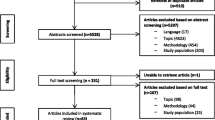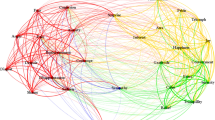Abstract
Self-reports in nursing homes generally show highly satisfied residents, whereas observational studies provide more nuanced results. In this study, which is based on self-determination theory, the perspective of nursing home residents (self-reports) is compared to the perspective of trained “neutral” observers (video-observations). The experiences of physically frail older residents are measured with regard to the fulfillment of their needs for relatedness, autonomy, and competence. Self-reports of need fulfillment in general, in the caring relationship, and during a caregiving episode recorded on videotape of 36 residents (64 % female, mean age 80 years) were compared with observer ratings of resident need fulfillment during the latter caregiving episode. Furthermore, it was investigated which measure relates best to residents’ self-reported well-being. The results show that residents rate their need fulfillment higher than observers. There is weak to moderate agreement between resident and observer ratings. Furthermore, only residents’ self-reported need fulfillment in general is related with self-reported well-being. Different explanations are provided, including the “barrier of happiness,” the use of cognitive strategies, a change in identity and existing power relations. There seems to be a paradox in caregiving: Residents and their needs should be central, but because residents might adapt their needs and wishes it is hard to assess these. Suggestions for practical applications are given.
Similar content being viewed by others
References
Brandtstädter J, Rothermund K (2002) The life-course dynamics of goal pursuit and adjustment: a two-process framework. Dev Rev 22:117–150. doi:10.1006/drev.2001.0539
Bronfenbrenner U (1979) The ecology of human development. Harvard University Press, Cambridge
Brooker D (2007) Person centred dementia care: making services better. Jessica Kingsley, London
Caris-Verhallen WMCM, Kerkstra A, Bensing JM (1997) The role of communication in nursing care for elderly people: a review of the literature. J Adv Nurs 25:915–933
Custers AFJ, Kuin Y, Riksen-Walraven JMA., Westerhof GJ (2009) Rating scales for the quality of interactions between caregivers and residents of somatic nursing homes. Unpublished Manuscript. Nijmegen: Behavioural Science Institute, Radboud University
Custers AFJ, Westerhof GJ, Kuin Y, Riksen-Walraven JMA (2010) Need fulfillment in caring relationships: its relation with well-being of residents in somatic nursing homes. Aging Ment Health 14:731–739. doi:10.1080/13607861003713133
Custers AFJ, Kuin Y, Westerhof GJ, Riksen-Walraven JMA (2011) Need support and well-being during morning care activities: an observational study on resident-staff interaction in nursing homes. Ageing Soc 31:1425–1442. doi:10.1017/S0144686X10001522
Custers AFJ, Westerhof GJ, Kuin Y, Gerritsen DL, Riksen-Walraven JMA (2012) Relatedness, autonomy, and competence in the caring relationship: the perspective of nursing home residents. J Aging Stud 26:319–326. doi:10.1016/j.jaging.2012.02.005
De Schipper EJ, Riksen-Walraven JMA, Geurts SAE (2006) Effects of child–caregiver ratio on the interactions between caregivers and children in child-care centers: an experimental study. Child Dev 77:861–874
Deci EL (2008) Self-determination theory: a macrotheory of human motivation, development and health. Can Psychol 49:182–185. doi:10.1007/s11031-008-9087
Den Draak M (2010) Oudere tehuisbewoners: landelijk overzicht van de leefsituatie van ouderen in instellingen. [Elderly in institutions: national overview of older residents’ living situation]. Sociaal en Cultureel Planbureau: Den Haag
Diener E, Suh EM, Lucas RE, Smith HL (1999) Subjective well-being: three decades of progress. Psychol Bull 125:276–302
Edelman P, Fulton BR, Kuhn D, Chang CH (2005) A comparison of three methods of measuring dementia-specific quality of life: perspectives of residents, staff, and observers. Gerontologist 45(suppl 1):27–36
Festinger L (1957) A theory of cognitive dissonance. Stanford UniversityPress, Stanford
Gagne′ M (2003) The role of autonomy support and autonomy orientation in prosocial behavior engagement. Motiv Emot 27:199–223
Gerritsen DL, Steverink N, Ooms ME, Ribbe MW (2007) Measurement of overall quality of life in nursing homes through self-report: the role of cognitive impairment. Qual Life Res 16:1029–1037. doi:10.1007/s11136-007-9203-7
Grainger K (2004) Communication and the institutionalized elderly. In: Nussbaum JF, Coupland J (eds) Handbook of communication and aging research. Lawrence Erlbaum Associates, Mahwah, pp 479–497
Guse LW, Masesar M (1999) Quality of life and successful aging in long-term care: perceptions of residents. Issues Ment Health Nurs 20:527–539
Heckhausen J, Wrosch C, Schulz R (2010) A motivational theory of life-span development. Psychol Rev 117:32–60. doi:10.1037/a0017668
Hollinger-Sampson N, Pearson JL (2000) The relationship between staff empathy and depressive symptoms in nursing home residents. Aging Ment Health 4:56–65
Jones EE, Nisbett RE (1971) The actor and the observer: divergent perceptions of the causes of behavior. General Learning Press, Morristown, New York
Jongenelis L, Pot A.-M, Eisses AMH, Beekman ATF, Kluiter H, Ribbe MW (2004) Prevalence and risk indicators of depression in elderly nursing home patients: the AGED study. J Affect Disord 83:135–142
Jongenelis L, Gerritsen DL, Pot A-M, Beekman ATF, Eisses AMH, Kluiter H et al (2007) Construction and validation of a patient- and userfriendly nursing home version of the Geriatric Depression Scale. Int J Geriatr Psychiatry 22:837–842
Kane RL, Kane RA, Bershadsky B, Degenholtz H, Kling K, Totten A, Jung K (2005) Proxy sources for information on nursing home residents’ quality of life. J Gerontol Soc Sci 60B:S318–S325
Kasser VM, Ryan RM (1999) The relation of psychological needs for autonomy and relatedness to health, vitality, well-being and mortality in a nursing home. J Appl Soc Psychol 29:935–954
Kelle U (2006) Combining qualitative and quantitative methods in research practice: purposes and advantages. Qual Res Psychol 3:293–311
Kitwood T (1997) Dementia reconsidered: the person comes first. Open University Press, Buckingham
Levy BR (2003) Mind matters: cognitive and physical effects of aging self-stereotypes. J Gerontol: Psychol Sci 58:203–211
Marcoen A, Coleman P, O’Hanlon A (2007) Psychol ageing. In: Bond J, Peace S, Dittman-Kohli F, Westerhof G (eds) Ageing in society: European perspectives on gerontology. Sage, London, pp 38–67
Moos RH (1976) The human context. Wiley, New York
Mozley C, Sutcliffe C, Bagley H, Cordingley L, Challis D, Huxley P, Burns A (2004) Towards quality care. Outcomes for Older People in Care Homes, Ashgate
Pavot W, Diener E (1993) Review of the satisfaction with life scale. Psychol Assess 5:164–172
Persson T, Wästerfors D (2009) “Such Trivial Matters:” how staff account for restrictions of residents influence in nursing homes. J Aging Stud 23:1–11. doi:10.1016/j.aging.2007.09.005
Philippe FL, Vallerand RJ (2008) Actual environments do affect motivation and psychological adjustment: a test of self-determination theory in a natural setting. Motiv Emot 32:81–89. doi:10.1007/s11031-008-9087-z
Roos JP (1988) Behind the happiness barrier. Soc Indic Res 20:141–163
Ryan RM, Deci EL (2002) Overview of self-determination theory: an organismic dialectical perspective. In: Deci EL, Ryan RM (eds) Handbook of self determination research. The University of Rochester Press, New York, pp 3–33
Sloane PD, Zimmerman S, Williams CS, Reed PS, Gill KS, Preisse JS (2005) Evaluating the quality of life QOL of long-term care residents with dementia. Gerontologist 45:37–49
Smalbrugge M, Jongenelis L, Pot A-M, Eefsting JA, Ribbe MW, Beekman ATF (2006) Incidence and outcome of depressive symptoms in nursing home patients in the Netherlands. Am J Geriatr Psychiatry 14:1069–1076
Spector A, Orrell M (2006) Quality of Life (QoL) in Dementia: a comparison of the perceptions of people with Dementia and care staff in residential homes. Alzheimer Dis Assoc Disord 20:160–165
Steverink N, Westerhof GJ, Bode C, Dittmann-Kohli, F (2001) Dutch aging survey: onderzoeksdesign en instrumenten. [Dutch Aging Survey: Research design and instruments]. Universiteit Nijmegen, Sectie Psychogerontologie, Nijmegen
Timko C, Rodin J (1985) Staff-patient relationships in nursing homes: sources of conflict and rehabilitation potential. Rehabil Psych 30(2):93–108
Tobin SS (1989) The effects of institutionalization. In: Markides KS, Cooper CL (eds) Aging, stress and health, Wiley, pp 139–163
Van Weert JCM, van Dulmen AM, Spreeuwenberg PMM, Ribbe MW, Bensing JZ (2005) Effects of snoezelen, integrated in 24 h dementia care, on nurse–patient communication during morning care. Patient Educ Couns 58:312–326
Author information
Authors and Affiliations
Corresponding author
Additional information
Responsible Editor: H.-W. Wahl.
Rights and permissions
About this article
Cite this article
Custers, A.F.J., Westerhof, G.J., Kuin, Y. et al. Need fulfillment in the nursing home: resident and observer perspectives in relation to resident well-being. Eur J Ageing 10, 201–209 (2013). https://doi.org/10.1007/s10433-013-0263-y
Published:
Issue Date:
DOI: https://doi.org/10.1007/s10433-013-0263-y




